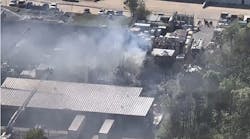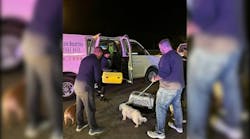On Wednesday, June 30, 2010, a two-alarm fire destroyed a historic commercial building in downtown Frederick, MD. Although the fire department did not have an adequate pre-plan of the site at the time of the incident, firefighters contained the blaze to the building of origin by the use of proper firefighting strategies and an effective command structure.
The two-story, Type IV heavy-timber building was constructed in three stages in the 1700s, 1800s and 1900s. Each section of the building contained approximately 600 square feet. The building had a pitched wooden roof covered with tin and contained office space, storage and light manufacturing areas. Smoke detectors were installed in the building.
First-In Units
The Frederick Fire Department was dispatched at 7 P.M. to a reported structure fire at 58 South Carroll St. Engines 31, 22 and 501 and Rescue Engine 11, all 1,250- to 1,500-gpm pumpers; Truck 41, a 100-foot, tractor-drawn aerial; Tower 1, a 105-foot aerial; Ambulance 38; and Frederick County Division of Fire and Rescue Services (DFRS) Battalion 901 and Safety 901 responded with 30 firefighters under the command of Deputy Fire/Rescue Chief Brendan T. Beaton of United Steam Fire Engine Company No. 3. On arrival, firefighters found fire on side A, Division 1. Firefighter life-safety issues included the possibility of collapse, heavy smoke conditions and poor visibility. It was confirmed that the building was unoccupied.
Engine 31 was positioned at the A/B corner of the building and Truck 41and Engine 22 were positioned on South Carroll Street (side A). Engines 22 and 31 each hooked onto a hydrant with one section of six-inch hard-suction to the front intake. The third engine, Rescue Engine 11, was positioned on side B and supplied by a 400-foot, four-inch hydrant line. Engine 502 was positioned on side A and fed by a 400-foot, four-inch hydrant line. Tower 1 was positioned at the A/B corner supplied by Engine 502.
Firefighters advanced a 200-foot, 2½-inch attack line to side B from Engine 31. A 200-foot, 1¾-inch attack line was also stretched to side B as a backup line. Firefighters advanced a 300-foot, 1¾-inch attack line from Engine 22 to the front of the building. A 200-foot, 2½-inch attack line was stretched to the front from Engine 22 as a backup line. Crews sustained an interior attack for approximately 15 minutes before being withdrawn due to deteriorating conditions.
As defensive operations began, Truck 42 was set up for ladder pipe operations and supplied by a 300-foot, four-inch line from Engine 22. Tower 1 placed two aerial master streams into operation supplied by a 200-foot, four-inch line from Engine 502. Engine 22 deployed a portable monitor device supplied by 100 feet of three-inch line to side A.
Multiple Alarms
Battalion Chief Kevin Finnin, command aide, requested a second alarm at 7:20 P.M., at the request of Beaton, the incident commander. The second alarm brought units from Frederick County Stations 11, 12, 20, 7 and 15. Each of these stations brought pumpers along with personnel. The engines were assigned to assist with the water-supply efforts while their personnel were assigned multiple tasks assisting with the defensive operation. Quint 11 was positioned on the B side of the structure and used its aerial master stream device for defensive operations on the B/C corner.
At 7:35 P.M., Finnin requested a third alarm to stage on South East Street. Frederick County Stations 22, 14 and 23 along with Carroll County Company 1 in Mount Airy, 27 miles away, responded with Carroll County Engine 12, a 1,250-gpm pumper. These units were used for manpower and to supply water to units already in operation. Beaton declared the fire under control at 9:45 P.M. Mutual aid units were released at 10 P.M.
Conclusion
Seventy firefighters responded to the scene with 15 engines and four trucks. Five hydrants were used on the municipal water system. Approximately 200,000 gallons of water was used to extinguish the fire. The weather at the time of the fire was sunny and clear.
The Frederick County Fire Marshal’s Office investigated the origin and cause of the fire. Investigators determined that a refrigerator located on the first floor malfunctioned. Damage was estimated at $2.5 million.
Among the lessons learned at this incident:
- Problems – At the time of the incident, the department did not have an adequate pre-plan of the building, including a standard operating procedure (SOP) for apparatus placement. The department is doing additional pre-planning of existing structures in its first-due area and reviewing SOPs regarding apparatus assignment and positioning.
- Successes – The fire was contained to the building of origin by the use of proper firefighting strategies and the use of an effective command structure. There were no firefighter or civilian injuries.





